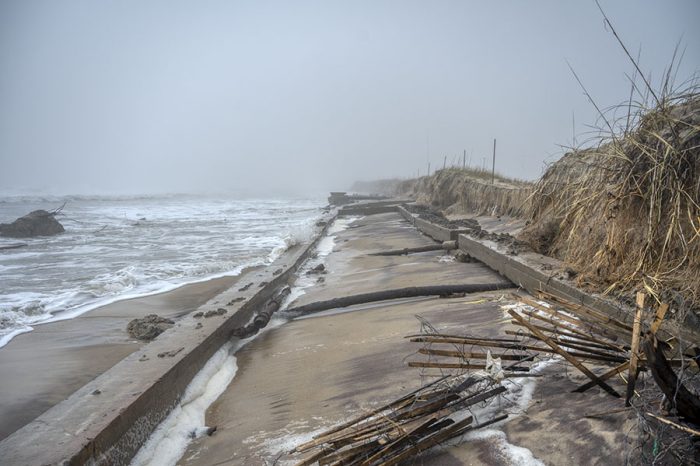
Since the Island Free Press (IFP) was launched 17 years ago, it has become an annual ritual to look back on the stories that grabbed attention or left a permanent mark. Started by our co-founder and original editor, Irene Nolan, it’s a tradition that we’ve been proud to carry on since she passed away in March 2017.
2022 was the year that the Jug Handle Bridge opened, the Frisco UFO burned down, and three oceanfront Rodanthe homes fell into the ocean. 2020 and 2021 were the years of the Coronavirus pandemic, and 2019 was the year of Hurricane Dorian.
Last year, with no major hurricanes or crises, was almost a precursor of sorts of what was to come. Because when it comes to reverberating Hatteras and Ocracoke Island news stories, 2024 stands out.
This was a year that saw massive developments in topics that the Island Free Press has covered for years.
There was plenty of bad news, such as the constant flooding of N.C. Highway 12 on Ocracoke Island, and more Rodanthe home collapses in a single year than ever before. But 2024 also had some optimism on the edges, as it was a year that visibly demonstrated the power of our local community when we get riled up and decide to take action.
With that in mind, let’s get started with one of the biggest and most complex stories of the year, which is quite a feat considering that 2024 also had six home collapses, a county-changing election, and a stark naked lighthouse.
Buxton Beach
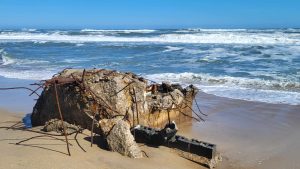
Buxton Beach first pinged on the radar in the fall of 2023, after two offshore hurricanes brushed the Outer Banks and uncovered infrastructure from a former military base, leading to a temporary beach closure at the end of Old Lighthouse Road.
Here’s a quick background of the many stories that followed:
- The 50-acre Buxton site was a military base for roughly 50 years, which shuttered for good in the 2010s.
- The consensus by stakeholders is that there are two agencies – the U.S. Army Corps of Engineers (USACE) and the U.S. Coast Guard (USCG) – who are responsible for cleaning up the recently exposed mess of petroleum and debris at the site. Because the Buxton Beach site is part of the Formerly Used Defense Site (FUDS) program, the USACE is responsible for addressing the petroleum contaminants related to Navy activity from 1956-1982, while the USCG is responsible for other potential contaminants that surfaced during their subsequent use of the property.
- Debate continues on which agency will purposely clean up all abandoned infrastructure, and will spearhead proactive steps to stabilize the beach, outside of an upcoming 2026 Buxton Beach nourishment project already planned by Dare County.
Intense coverage began in February 2024 when two corresponding events happened within a week.
Following a typical winter storm, surfers exited the ocean at Old Lighthouse Beach reeking of fuel. It was a phenomenon that was documented and shared by local surfer Brett Barley, which went viral due to his impactful social media presence.
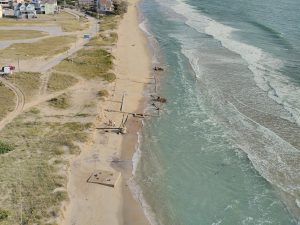
Days later, the USACE stated in an email to the Island Free Press that, after months of testing with mixed results, there were no plans to conduct any remediation efforts in the area because the source of petroleum could not be located.
Here is that initial February 15 quote:
“We (USACE) have conducted subsurface investigations at various locations on the beach and have not found a source of petroleum… Unfortunately, in the absence of a source, the FUDS program cannot take any action at the site… USACE FUDS needs to confirm there is a source associated with Navy activity at the site for this matter to fall within the scope of the FUDS Program.”
This response, coupled with the fact that surfers and beachgoers were seeing the issues every single day, was an early turning point of the story that sounded an initial alarm.
Looking back, a packed March meeting on the issue, where frustrations were evident, was a second catalyst that sparked a fire in residents which caught hold and spread.
This is how the new-in-2024 Buxton Civic Association was formed. This is how Dare County Commissioners stepped up to launch meetings in Washington D.C. and close to home, and this is where allies began to take notice and get involved.
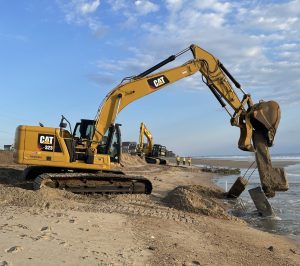
There were certainly waves of progress and setbacks in the months that followed, and condensing more than 60 IFP stories on the topic – roughly 100,000 words – is impossible, and frankly, would be terribly boring to read.
So here are the key takeaways to come out of Buxton Beach this past year:
- The USACE stated that they were able to visibly see the issues after a storm in September 2024, and shortly afterwards, they launched an aggressive 60-day response action which led to the reopening of Old Lighthouse Beach just days before Christmas. The original .25-mile beach closure remains as remediation work continues, which includes in-depth USACE testing to determine the next steps.
- Per a December update from the USACE, a Buxton Restoration Advisory Board is also on the horizon for the Buxton Naval Facility, following a recent survey that showed deep community interest.
- It’s fair to say that while the local community was exasperated with the lack of response from the USACE during the first few months of 2024, this bitterness and frustration has been reversed. The USACE stepped up and made visible progress, and will be actively involved in whatever comes next.
- Then there’s the Coast Guard, who also played a role in leaving behind chemicals and debris on the Buxton shoreline. In October, the Coast Guard released the findings of a year-long Comprehensive Environmental Response, Compensation and Liability Act (CERCLA) investigation at Buxton Beach, stating that there were no “actionable levels” of contaminants from the Coast Guard’s roughly 30-year use of the site. The National Park Service is reviewing these findings, which per multiple reports, are based on industrial and not residential standards. In short, expect more coverage on this aspect of the Buxton Beach story in the months to come.
- Hatteras Islanders have the power to change things. In my 25 years as a local journalist, I don’t think I have ever seen such an example of local momentum leading to truly demonstrative results. Public pressure will never be credited as a reason why certain developments occurred, but it’s hard not to make a reading-between-the-lines assessment when it comes to where we are now, versus where we were a year ago.
Simply put, if you love Buxton Beach, then the next time you see members of the Buxton Civic Association, Dave Hallac, Mike Barber, Danny Couch, Susan Sigmon, Deb Hoyt, Brett Barley, Dare County’s Commissioners, and many, many others out and about, then you should buy them a beer. (Get ready for a hefty bar tab, because a ton of people got this ball rolling.)
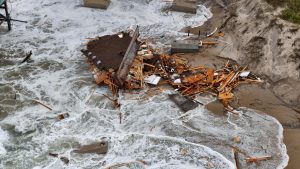
Rodanthe home collapses
Unfortunately, 2024 was a milestone when it comes to the progression of home collapses in northern Rodanthe, as there were a total of six homes that fell into the ocean this past year, starting in May.
Three of these homes collapsed within a four-day timeframe in September, and the most recent home collapse occurred just a few weeks ago on November 15.
This will likely be a topic that we’ll be forced to cover again in 2025 as well, as there are around two dozen homes that remain in danger in northern Rodanthe, and also in Buxton.
While the community’s eyes will be on the oceanfront during the next few storms, here’s hoping that 2024’s six home collapses is a record that won’t be broken or repeated next year.
Lighthouse renovations
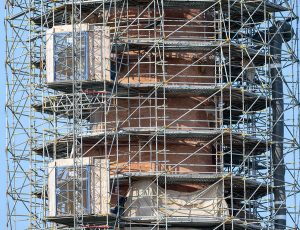
On a happier note, 2024 was also the year that saw major headway on two corresponding lighthouse projects – the total restoration of the Cape Hatteras Lighthouse, and the renovation of the Double Keepers’ Quarters on Ocracoke Island.
As of the end of 2024, both sites are very much works in progress.
On Ocracoke, the lifting of the Keepers’ Quarters to protect it from future flooding events is imminent, and on Hatteras Island, the lighthouse is simply unrecognizable.
In 2024, the Cape Hatteras Lighthouse was encased in a tower of scaffolding, stripped of its iconic black and white stripes to make way for fresh paint, and was outfitted with a new temporary lens while a replica is built from scratch.
The Cape Hatteras Lighthouse is expected to be fully open by the summer of 2026, with many more steps to go before its completion, so expect plenty of upcoming updates on the next steps – like the exterior painting which is slated to start in the spring of 2025.
Dredging issues
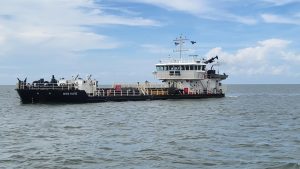
Dredging challenges in the channels of Hatteras Inlet are unfortunately familiar territory, but 2024 presented two new and slightly more unusual dredging issues for the Outer Banks.
In July, the Dare County Waterways Commission learned that the emergency channel between Rodanthe and the Dare County mainland would not be accessible for ferries to provide supplies or evacuations if N.C. Highway 12 became impassable.
This problem, which came to light at the beginning of hurricane season, received intense attention from the community and the county, and the emergency channel was subsequently dredged weeks later, thanks to swift action from the Dare County Board of Commissioners and other county officials.
The other dredging story was – and is – a little more complicated. In September, the U.S. Army Corps of Engineers Wilmington District suspended Dare County’s permits for dredging in Oregon and Hatteras Inlets for violations by the dredge Miss Katie.
According to a press release, the USACE stopped all work conducted by EJE Dredging Service, which owns and operates the $15 million Miss Katie dredge that is funded by the state and county. Several permits were restored weeks later after meetings with county officials, but with ongoing investigations into EJE Dredging and its top official Jordan Hennessy, expect this larger story to linger in the headlines in 2025.
N.C. Highway 12 on Ocracoke Island
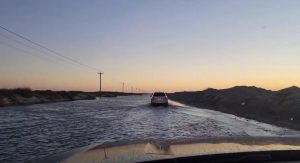
Sporadic flooding on N.C. Highway 12 is not groundbreaking news, but in the past year, even seasoned locals were surprised at how vulnerable the highway on northern Ocracoke Island had become.
N.C. 12 on Ocracoke Island was temporarily closed due to ocean overwash multiple times in January, February, March, April, September, and November, and despite a May 2024 project to replace sandbags along the roadway, the highway remains in danger every time there is a storm, heightened wave action, or just extreme high tides.
Way back in 2023, the N.C. 12 Task Force examined potential solutions for northern Ocracoke Island as one of the islands’ seven vulnerable hot spots, and came up short on inexpensive and viable options.
Long-term proposals, like moving the Hatteras-Ocracoke ferry’s South Dock closer to Ocracoke village or enlisting more passenger ferries, are still in a hazy idea phase, so it’s probable that temporary highway closures connected to ocean overwash will continue well into 2025.
A new Board of Commissioners
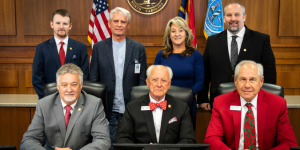
Three new Dare County Commissioners were sworn in on December 2, following a November election that saw a Republican sweep in Dare County.
Local Republicans clinched all seats on the Board of Commissioners and Board of Education in the Nov. 5 election, with 25,159 out of 34,103 eligible voters (73.77%) casting ballots in Dare County.
Dare voters also leaned Republican on all state and federal races, with 58.74% of local ballots cast for Trump, 51.35% for Mark Robinson, (who lost the statewide Governor race to Josh Stein), and approximately 60% of county ballots cast for Republican candidates in all other state races.
The newly-elected commissioners include Mike Burrus and Caron Creef representing District 1, (or East Lake, Stumpy Point, Manns Harbor, Manteo, and Wanchese), as well Mary Ellon Ballance, who is Hatteras Island’s new District 4 representative.
Ballance is the first new commissioner for Hatteras Island in eight years, and was elected after former Commissioner Danny Couch announced his retirement. The Island Free Press spoke with both Couch and Ballance to highlight the transition, and you can read their interviews here.
Chicamacomico Life-Saving Station’s 150th Anniversary
Another bright spot in 2024 was a milestone moment for one of Rodanthe’s most famous landmarks, as the Chicamacomico Life-Saving Station (CLSS) celebrated its 150th anniversary and its prestigious status as one of the first seven life-saving stations to be built in North Carolina.
The 1874 establishment of U.S. Life-Saving Service in N.C. had reverberations that are still very much noticeable today. The seven stations – all located within the Outer Banks – created new communities and generations of locals that still call the Outer Banks home. In 1915, the Life-Saving Service became the United States Coast Guard, and throughout the past 150 years, thousands of lives have been saved off of local shores because of these two successive agencies.
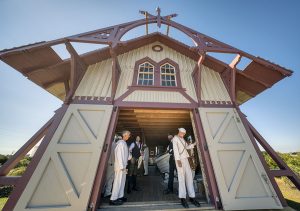
This deep history and interwoven connections were highlighted at a two-day 150th Anniversary event In October, as well as through a series of articles on the history of the Life-Saving Service that were meticulously written by Jen Carlson for CLSS.
While the 150th anniversary ends with the close of 2024, there’s still lots of good news on the horizon for this beloved museum and historic site, as an ongoing restoration of the 1874 Chicamacomico Station continues well into 2025, and likely beyond.
What’s next, 2025?
With so many in-process projects and evolving stories, most of the topics that were big news in 2024 will carry over into 2025 as well. Expect new developments on Buxton Beach, the two lighthouse restoration projects, and other familiar matters in the next few weeks, or even the next few days.
In the meantime, all of us at the Island Free Press hope that your 2024 was a banner year, despite any challenges our community confronted, and that 2025 will be even better.
Thank you for reading the IFP, and we truly look forward to sharing the island stories that matter the most to you in the months, years, and decades ahead.



